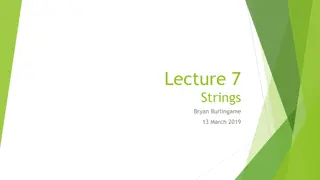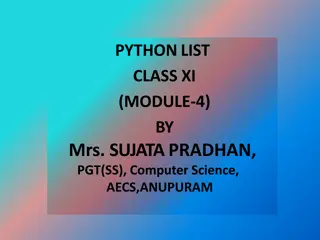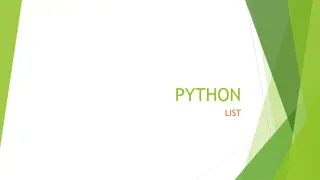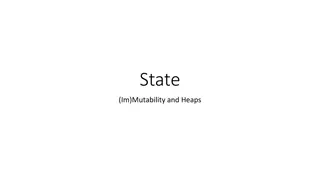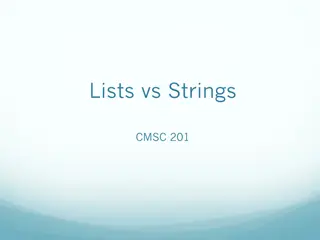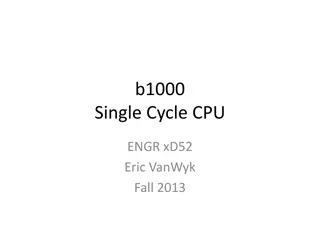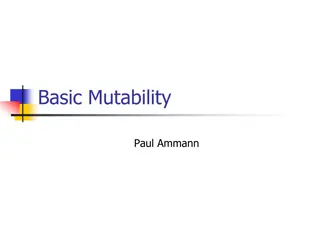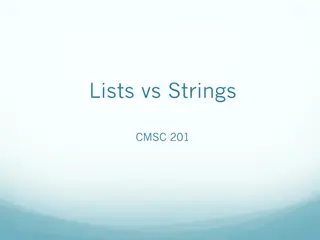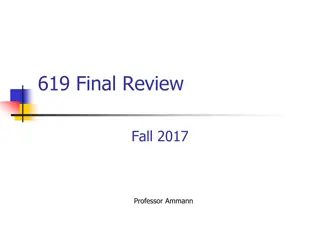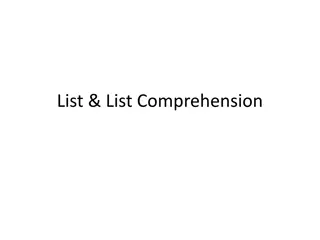
Understanding Mutability and Immutability in Python
Explore the concepts of mutability and immutability in Python through examples and explanations covering variable reassignment, object mutation, constructors, access expressions, and more. Learn how to differentiate between changing bindings and modifying objects, and discover the implications for sharing data effectively. Dive deep into the nuances of variables, objects, and their behavior in Python programming.
Download Presentation

Please find below an Image/Link to download the presentation.
The content on the website is provided AS IS for your information and personal use only. It may not be sold, licensed, or shared on other websites without obtaining consent from the author. If you encounter any issues during the download, it is possible that the publisher has removed the file from their server.
You are allowed to download the files provided on this website for personal or commercial use, subject to the condition that they are used lawfully. All files are the property of their respective owners.
The content on the website is provided AS IS for your information and personal use only. It may not be sold, licensed, or shared on other websites without obtaining consent from the author.
E N D
Presentation Transcript
Sharing, mutability, and immutability Ruth Anderson UW CSE 160 Autumn 2022 1
Topics for Today variables and objects Changing/creating bindings vs. changing/modifying objects Mutability vs. immutability Review of types 2
See in python tutor Copying and mutation list1 = ["e1", "e2"] list2 = list1 list3 = list(list1) # make a copy; also list1[:] print(list1, list2, list3) list1.append("e3") list2.append("e4") list3.append("e5") print(list1, list2, list3) list1 = list3 list1.append("e6") print(list1, list2, list3) 3
An aside: List notation Possibly misleading notation: list four score and seven years More accurate, but more verbose, notation: list four score and seven years four score and seven years 4
Variable (re)assignment vs. Object mutation (Re)assigning a variable changes a binding, it does not change (mutate) any object (Re)assigning is always done via the syntax: my_var = expr size = 6 list2 = list1 Changes what the variables size and list2 are bound to Mutating (changing) an object does not change any variable binding Two syntaxes: left_expr = right_expr Changes something about the object that my_list refers to Examples: my_list[3] = val expr.method(args ) my_list.append(val) 5
New and old values Every expression evaluates to a value It might be a new value It might be a value that already exists A constructor evaluates to a new value: lst1 = [3, 1, 4, 1, 5, 9] lst2 = [3, 1, 4] + [1, 5, 9] lst3 = [[3, 1], [4, 1]] An access expression evaluates to an existing value: x = lst1[1] y = my_dict["rea"] What does a function call evaluate to? z = mystery(arg) In all 3 examples here the right hand side of = is a constructor 6
Example: Variable reassignment or Object mutation? def change_val(lst): lst[0] = 13 def append_val(lst): lst.append(99) def mystery(lst): lst = lst + [99] return lst See in python tutor lst2 = [1, 2] change_val(lst2) append_val(lst2) lst3 = mystery(lst2) 7
See in python tutor Example: Lists of lists def make_new_grid(input_grid): """Make a new grid that is a copy of input_grid. Set location [0][0] in new grid to be 99. Do not modify input_grid.""" new_grid = [] for row in input_grid: new_grid.append(row) new_grid[0][0] = 99 return new_grid grid1 = [[1, 2, 3], [4, 5, 6]] grid2 = make_new_grid(grid1) print("grid1:", grid1) print("grid2:", grid2) 8
See in python tutor Aside: Object identity An object s identity never changes Can think of it as its address in memory Its value of the object (the thing it represents) may change my_list = [1, 2, 3] other_list = my_list my_list.append(4) my_list is other_list True my_list and other_list refer to the exact same object my_list == [1, 2, 3, 4] True The object my_list refers to is equal to the object [1,2,3,4] (but they are two different objects) my_list is [1, 2, 3, 4] False The object my_list refers to is not the exact same object as the object [1,2,3,4] Use == to check for equality, NOT is 9 Aside: Using is with None is o.k: if x is None:
Object type and variable type An object s type never changes A variable can get rebound to a value of a different type Example: The variable a can be bound to an int or a list a = 5 a = [1, 2, 3, 4] A type indicates: what operations are allowed the set of representable values type(object) returns the type of an object 5 is always an int [1, 2, 3, 4] is always a list 10
New datatype: tuple Like lists, tuples represents an ordered sequence of values Like strings, tuples are immutable The elements of a tuple can be anything (including mutable types) Examples: () (4, 7, 9) ("hi", [1, 2], 5) 11
Tuple operations Constructors Literals: Use parentheses ("four", "score", "and", "seven", "years") (3, 1) + (4, 1) => (3, 1, 4, 1) # creates a new tuple! Queries Can index just like lists: tup = ("four", "score", "and", "seven", "years") print(tup[0]) => "four" print(tup[-1]) => "years" Mutators Like strings, tuples are immutable, so have no mutators 12
Immutable datatype An immutable datatype is one that doesn t have any functions in the third category: Constructors Queries Mutators: Does not have any! Immutable datatypes: int, float, boolean, string, tuple, frozenset Mutable datatypes: list, dictionary, set 13
Remember: Not every value may be placed in a set Set elements must be immutable values int, float, bool, string, tuple not: list, set, dictionary The set itself is mutable (e.g. we can add and remove elements) Aside: frozenset must contain immutable values and is itself immutable (cannot add and remove elements) 14
Remember: Not every value is allowed to be a key in a dictionary Remember: Dictionaries hold key:value pairs Keys must be immutable int, float, bool, string, tuple of immutable types not: list, set, dictionary Values in a dictionary can be mutable The dictionary itself is mutable (e.g. we can add and remove elements) 15
Mutable and Immutable Types Immutable datatypes: int, float, boolean, string, function, tuple, frozenset Mutable datatypes: list, dictionary, set Note: a set is mutable, but a frozenset is immutable 16
See in python tutor Tuples are immutable Lists are mutable def update_record(record, position, value): """Change the value at the given position""" record[position] = value my_list = [1, 2, 3] my_tuple = (1, 2, 3) update_record(my_list, 1, 10) print(my_list) update_record(my_tuple, 1, 10) print(my_tuple) 17
See in python tutor Increment Example def increment_count(words_dict, word): """increment the count for word""" if word in words_dict: words_dict[word] = words_dict[word] + 1 else: words_dict[word] = 1 def increment_val(value): """increment the value???""" value = value + 1 my_words = dict() increment_count(my_words, "school") print(my_words) my_val = 5 increment_val(my_val) print(my_val) 18

